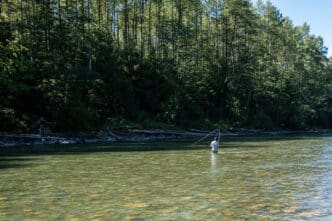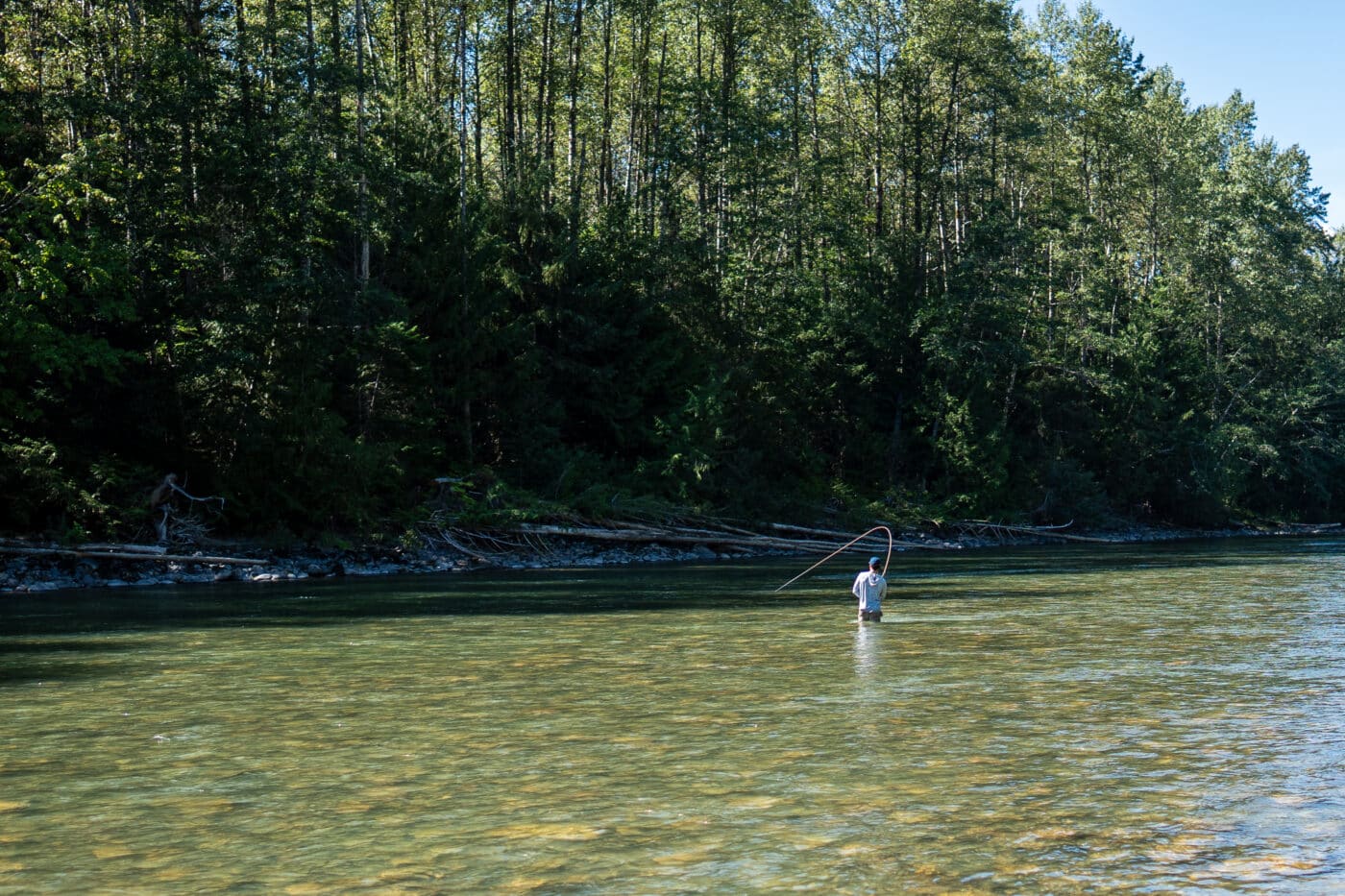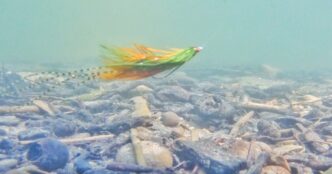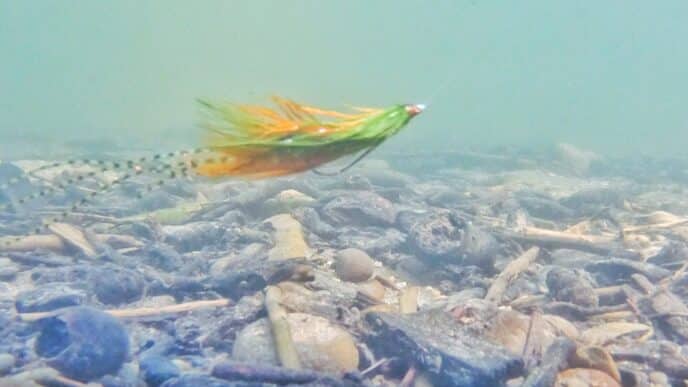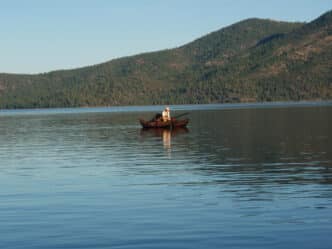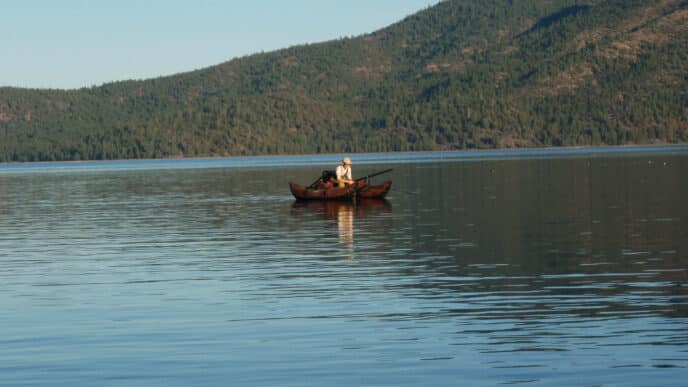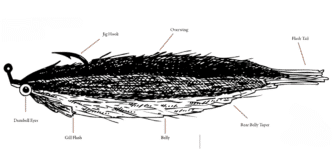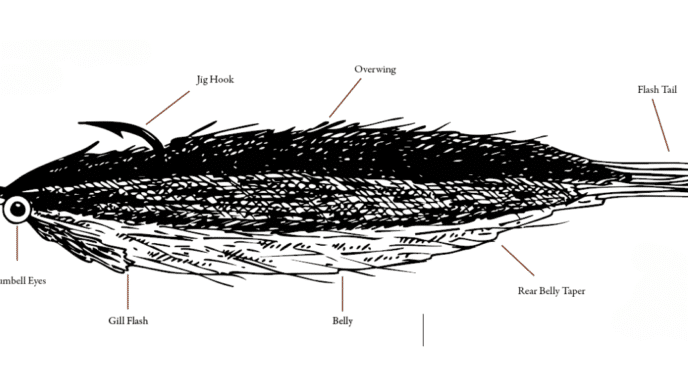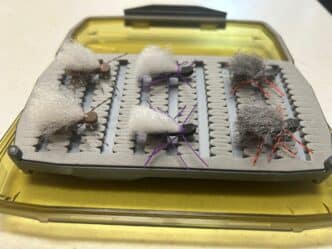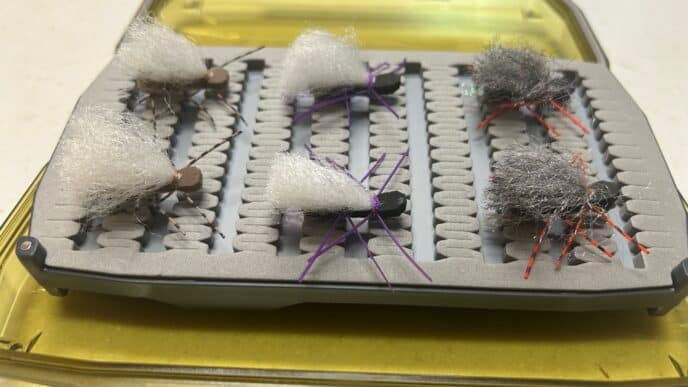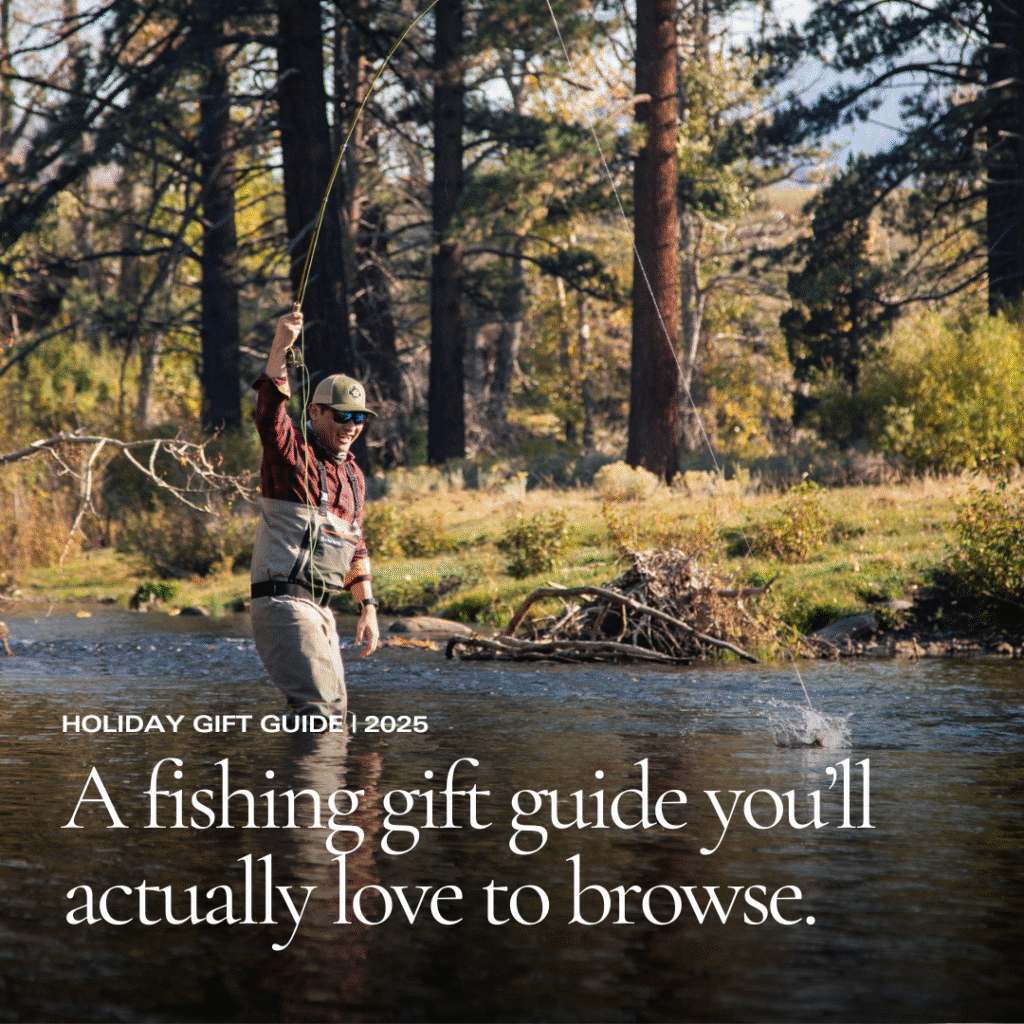Story and photos by George Revel
My first steelhead on the swing still replays in my mind today. The scene opens on a hot July day.
I cast a black Woolly Bugger into a shady spot on the Trinity River. As soon as the fly swings into the sun, a silver torpedo shoots out from the shade and smashes the fly. Cartwheels and long runs follow until I finally hold the fish in the water, stunned in disbelief.
“Fish of a thousand casts!” I had always heard, but this was only my third cast of the day. This stroke of luck marked the beginning of a lifelong obsession with steelhead, spanning across three countries and four states and killing more than one relationship. Twenty years later and thousands of hours spent swinging for steelhead, and nearly every lesson was learned right there in my very first experience. Just go, it’s easy.
You can fish for steelhead every month of the year, but the purest joy I’ve found is during the wet-wading months of July throught October. If there’s a more enjoyable fishing experience than this, I haven’t found it. If you are just embarking on your steelhead journey, I hope you realize the impending good fortune that awaits.
UNDERSTANDING SUMMER-RUN STEELHEAD
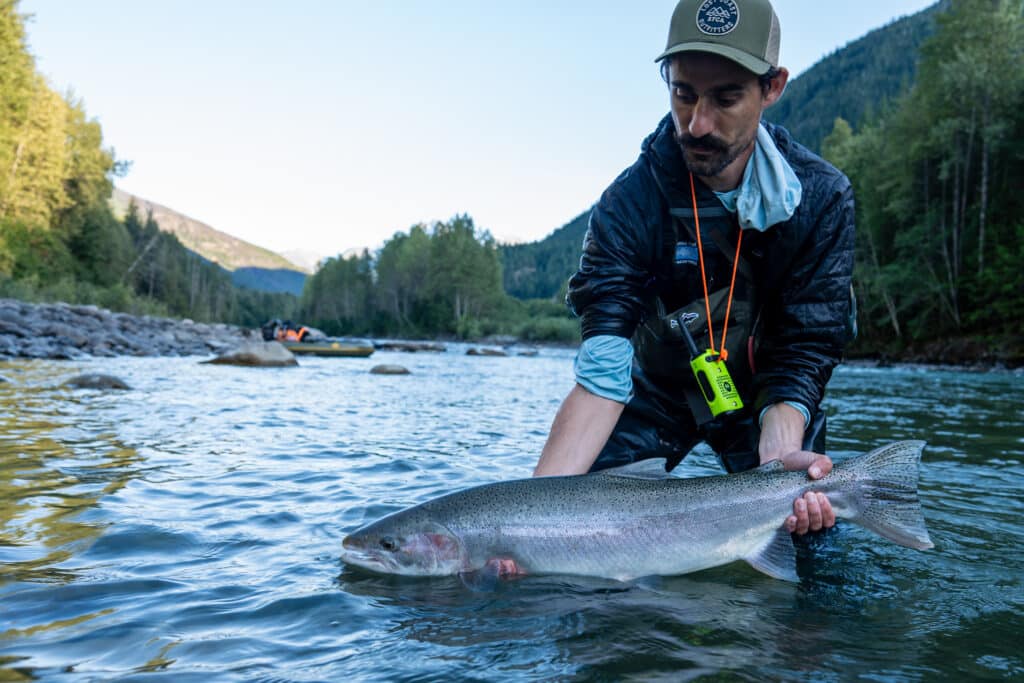
Steelhead are a mysterious fish and their life histories are often misunderstood by anglers. During the summer months, ocean-fresh, chrome-bright, summer-run steelhead generally migrate up long river systems flowing from headwaters that lie far inland. This marks the beginning of a months-long journey, sometimes over hundreds of miles, during which steelhead over-winter in the river system until they spawn in the spring. On their way upriver, fish generally maintain their oceanic tendencies by traveling in pods.
I love imagining the path the fish will take on their upriver journey, filtering into a run, resting, and continuing upstream.
Typically, they look for deeper, slower pools near tributaries to spend the winter. Like any anadromous fish, it’s more desirable to catch them closer in time and proximity to the ocean, while they are on the move. However, due to the long time they spend in freshwater, summer-run steelies are available to the angler for a longer period of time, with June through November being the main season. Once cold weather really kicks in, it’s better to go search for fresh winter steel—a topic for another time.
The juvenile fish spend anywhere from one to three years in the river before migrating to the ocean, where they may spend an additional one to three years (or more) before returning to their natal stream.
SWINGING FOR SUMMER STEELHEAD
Fly fishing for steelhead may seem complex, but the reality is, it’s pretty simple. Steelhead are not hard to catch, they are just hard to find. There is no “match the hatch,” no 6X tippet, no size-20 flies, and no complicated rigs that require spending 20 minutes tying. Often, you don’t even need to mend! The following maxims and tips will help you achieve success when fishing for summer steelhead.
Identify Holding Water
If you are coming from the trout world, keep in mind good trout water is not necessarily good steelhead water. Steelhead are seeking a place to rest on their journey upstream. When targeting steelhead, think about the path of least resistance. Obstacles like heavy rapids may cause fish to congregate above and below. Sections of the river that are flat, with subsurface structure, often provide restful places. There are three main parts of steelhead water that we target: the head, the gut, and the tailout.
The head of the run can be very productive, especially midday when the sun is high. While the water may appear to be raging, the drop-off in gradient creates a pocket of soft water below the surface. The broken surface caused by the turbulence not only oxygenates the water, but also deflects the bright sun, creating a more likely scenario for the fish to see your fly. Additionally, broken water makes fish more invisible to winged predators flying overhead. I like to imagine the fish nosed right up into the drop-off in the soft water below the fast water. Start high in the riffle with short casts and work your way down until you get to the gut of the run. Make sure that you allow your fly to finish the swing, into the soft water on the inside.
The gut of the run is where the current becomes less condensed and broadens out. This is where you can start to lengthen your cast out a bit and achieve a good, long swing. As you lengthen your line, fish from a fixed position to make sure you are covering the water. Once you’ve achieved your maximum casting distance, begin methodically moving downriver between swings. Here, you start to take bigger steps and cover water faster, provided you have good water clarity. If I notice some particularly juicy water with large boulders, I tend to slow down and fish more methodically, while fishing faster through the less appealing areas. As you get toward the bottom of the run, or the tailout, you can start to really lengthen out your cast.
The tailout is the place to really show off your cast and stretch out. It is often the widest part of the run. Again, the water may look fast, but fish love to hang here. Make sure you fish your fly all the way back into the choppy bits as the tailout breaks into the head of the next riffle.
Gear
My preferred summer steelhead rod ranges from a 4-weight trout Spey on the upper reaches of the Klamath and Trinity, to a 7-weight 13-foot rod for impressive fish in northern British Columbia. Both Skagit and Scandi style lines have a place in the summer steelheader’s quiver. Ideally, you’d have one rod rigged up with a Skagit line and sink tip and another rod with floating Scandi line and 12-foot leader for skating a dry fly—though the snobbiest of summer steelhead anglers would not stoop to throwing a sink tip during the summer run.
Casts
Having a stealthy cast is essential when targeting summer steelhead in low, clear water. You want to cast in a way that allows your leader to extend fully while not ripping on the water’s surface during the setup or smashing down on delivery. Often, a straight-line cast quartered downstream will do the trick. My preferred casts when targeting summer steelhead are the Snake Roll and Single Spey. They offer incredible power and control with minimal setup noise on the water when compared to the Snap T or Double Spey. Additionally, these two “touch-and-go” casts are more time efficient and allow you to cover more water during a fishing session.
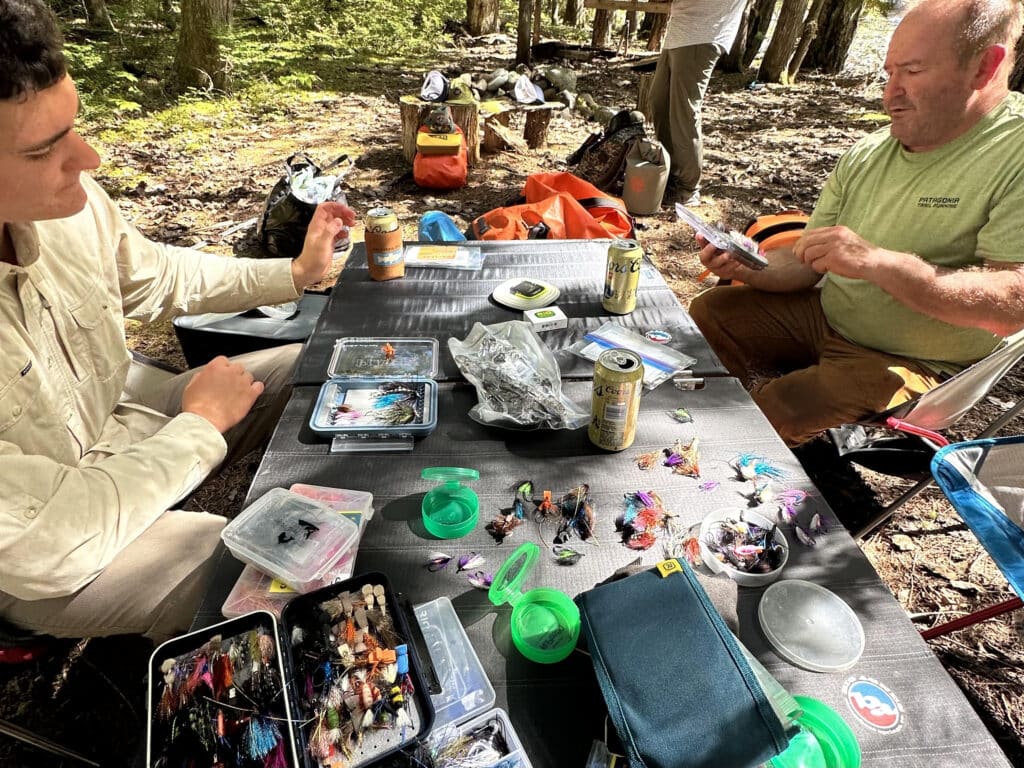
Time of Day—Sun and Shade
I prefer fishing mornings and evenings, when the sun is at a low angle and not directly overhead. Steelhead are generally more comfortable and willing to take a fly in lower light conditions. During summer, however, we don’t always have that luxury.
I recommend a few strategies for targeting fish in the full sun. In the middle of the day, fishing a sink tip in the head and gut of the run can produce some great fish. Another strategy I employ in bright sun is fishing a fly with some flash that pushes water, for example, a Muddler variant with some flashy tinsel on the body. Lastly, find what shade IS available. A good summer steelhead guide will know what time runs are going to be shaded. All my summer steelhead notes record when the sun comes off the water on different runs. A note in my summer steelhead journal might read, “8/12/2024 Sandy Beach Run, Trinity River 4:15 pm shaded.” The reality, though, is you will typically find your best fishing in the first light and last light of the day. So, don’t burn yourself out by fishing all day in the hot summer sun—take a nap and make the most of the early morning and evening windows.
A Grab or a Boil
The key here is to do very little when a fish grabs. Keep the rod tip pointed at the fish and wait until the fish turns and pulls line off the reel. Gently lift the rod toward the bank to try and bury the fly in the corner of the fish’s mouth.
It is common, when fishing dry flies, for a fish to miss the fly—an exciting event indicating you have found a player. All is not lost if this happens. Standard operating procedure is to recall the cast you just made and note your position in the river. First step: walk three or four casts back upstream and begin the process of fishing back down to the fish. Often, allowing the fish some time to reset to its position is enough to elicit a second grab. If that doesn’t do the trick, changing to a smaller fly or one that rides just below the surface, like a Muddler, can be enough to entice the fish into another attempt to hang itself on the end of your line.
Summer Steelhead Rivers
We are lucky here in California to have access to two incredible summer-run steelhead fisheries—the Klamath River and Trinity River. Just over the California border lie the Rogue and the North Umpqua, one of the most legendary summer-run fisheries in the world. Add to that, our Central Valley rivers, like the Feather, American and Lower Sacramento, which offer enough steelhead fishing to keep you busy when you can’t make a longer trek north.
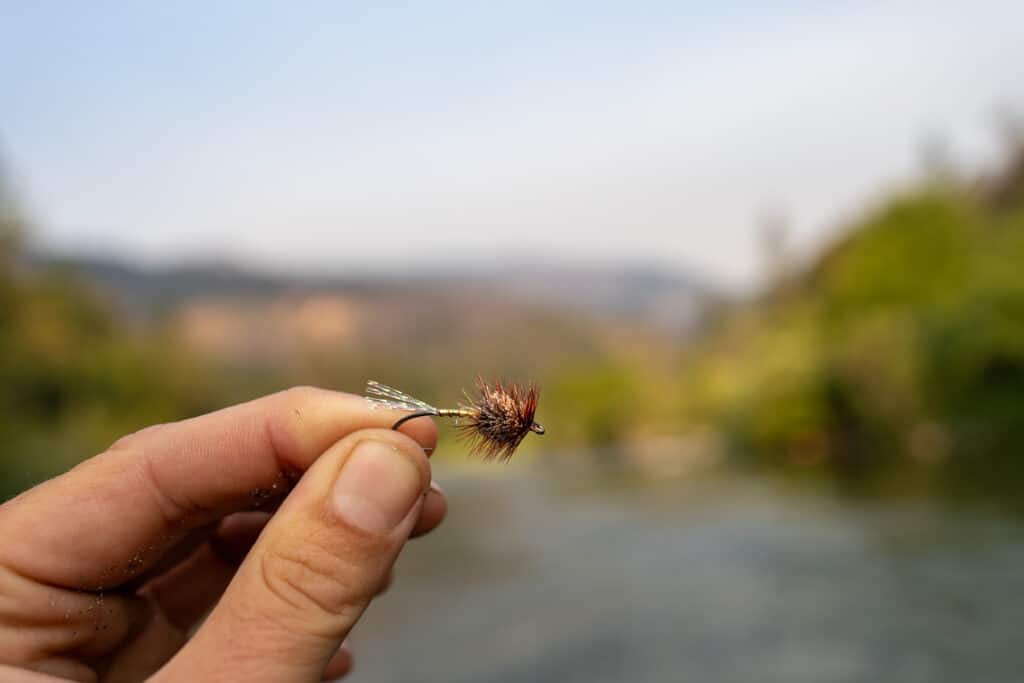
GEORGE’S FAVORITE SUMMER STEELHEAD FLIES
Concerning flies, I don’t think what fly you use matters much, as long as it is one of these:
- A good skater: #5 Brett’s Klamath Skater (October Caddis color is money)
- A waking fly for in the surface film: #6 Muddler Minnow
- A grease line fly: #6 Silver Hilton
- Something buggy: #6 Brindle Bug
- Something flashy: #5 Wedeking Jayhawker
- Sub-Surface: Burnt Chicken in black
- Check out our summer steelhead fly six-pack at Lost Coast Outfitters
FINAL THOUGHTS
Swinging flies for summer-run steelhead is not about numbers—no steelhead fishing is. It’s about the boil on a dry fly, the surge of a fish cartwheeling downstream, the way first light filters over the ridge, intercepting a pod of hot fish, t-shirts and sunscreen and maybe most importantly, wet wading… sorry wader companies.
Steelhead are imperiled, so we must take special precautions when handling and fishing for them.
• Use a tippet of the appropriate size. No reason to go below 12-pound when swinging.
• Do not handle them with gloves.
• Keep the fish wet–there is no reason to remove them from the water.
• Use a net and don’t beach the fish.
• Pinch your barbs.
• Follow all regulations.
• Be active in steelhead conservation


